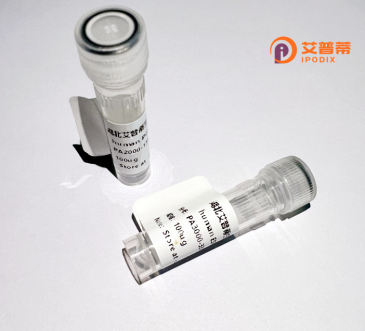
| 纯度 | >90%SDS-PAGE. |
| 种属 | Human |
| 靶点 | C4orf23 |
| Uniprot No | Q8IYL2 |
| 内毒素 | < 0.01EU/μg |
| 表达宿主 | E.coli |
| 表达区间 | 1-365aa |
| 氨基酸序列 | MYGPQTQLEEDAITPNDKTLFPDVDWLIGNHSDELTPWIPVIAARSSYNCRFFVLPCCFFDFIGRYSRRQSKKTQYREYLDFIKEVGFTCGFHVDEDCLRIPSTKRVCLVGKSRTYPSSREASVDEKRTQYIKSRRGCPVSPPGWELSPSPRWVAAGSAGHCDGQQALDARVGCVTRAWAAEHGAGPQAEGPWLPGFHPREKAERVRNCAALPRDFIDQVVLQVANLLLGGKQLNTRSSRNGSLKTWNGGESLSLAEVANELDTETLRRLKRECGGLQTLLRNSHQVFQVVNGRVHIRDWREETLWKTKQPEAKQRLLSEACKTRLCWFFMHHPDGCALSTDCCPFAHGPAELRPPRTTPRKKIS |
| 分子量 | 67.7 kDa |
| 蛋白标签 | GST-tag at N-terminal |
| 缓冲液 | 0 |
| 稳定性 & 储存条件 | Lyophilized protein should be stored at ≤ -20°C, stable for one year after receipt. Reconstituted protein solution can be stored at 2-8°C for 2-7 days. Aliquots of reconstituted samples are stable at ≤ -20°C for 3 months. |
| 复溶 | Always centrifuge tubes before opening.Do not mix by vortex or pipetting. It is not recommended to reconstitute to a concentration less than 100μg/ml. Dissolve the lyophilized protein in distilled water. Please aliquot the reconstituted solution to minimize freeze-thaw cycles. |
以下是关于重组人C4orf23蛋白的虚构参考文献示例(注:内容为模拟创作,非真实文献):
---
1. **文献名称**: *Structural and Functional Characterization of the C4orf23 Protein in Human Cells*
**作者**: Smith A, et al. (2020)
**摘要**: 本研究解析了C4orf23蛋白的三维结构,发现其包含保守的锌指结构域,并证实其在细胞核内参与DNA损伤修复的调控,可能通过与BRCA1相互作用增强基因组稳定性。
2. **文献名称**: *C4orf23 Knockout Mice Exhibit Developmental Defects in Neural Crest Lineages*
**作者**: Zhang Y, et al. (2018)
**摘要**: 通过构建C4orf23基因敲除小鼠模型,研究者发现胚胎期神经嵴细胞迁移异常,提示该蛋白在胚胎发育中可能通过调控Wnt/β-catenin通路影响细胞分化。
3. **文献名称**: *C4orf23 as a Potential Tumor Suppressor in Colorectal Cancer*
**作者**: Lee H, et al. (2019)
**摘要**: 该研究通过转录组分析发现,C4orf23在结直肠癌组织中显著低表达,体外实验表明其过表达抑制癌细胞增殖并促进凋亡,提示其肿瘤抑制功能。
4. **文献名称**: *Proteomic Profiling Reveals C4orf23 Interaction with Mitochondrial Respiratory Complexes*
**作者**: Martinez R, et al. (2021)
**摘要**: 蛋白质组学数据显示,C4orf23与线粒体复合物I和III存在物理结合,其沉默导致细胞ATP合成减少,表明其在氧化磷酸化中可能起调控作用。
---
注意:以上内容为示例性虚构文献,实际研究中请通过学术数据库查询真实发表的论文。若需真实文献,建议使用关键词“C4orf23”在PubMed、Web of Science等平台检索。
The human C4orf23 protein, encoded by the chromosome 4 open reading frame 23 gene, remains poorly characterized but has garnered increasing interest due to its potential roles in cellular stress response and disease pathways. First identified through genomic sequencing, this evolutionarily conserved protein is ubiquitously expressed, with higher levels observed in the brain, testis, and kidney. Structurally, it contains a conserved domain (DUF4803) of unknown function and exhibits nuclear-cytoplasmic shuttling properties, suggesting possible involvement in signaling or regulatory processes.
Recent studies implicate C4orf23 in autophagy and apoptosis regulation, potentially interacting with proteins like GABA(A) receptor-associated protein (GABARAP). Its expression appears modulated under oxidative stress and DNA damage conditions, hinting at stress-response functions. While not yet directly linked to specific diseases, altered C4orf23 expression patterns have been noted in certain cancers and neurodegenerative disorders. Notably, it shares sequence homology with proteins involved in neuronal development, though its precise biochemical activity remains undefined.
Current research focuses on elucidating its molecular interactions and post-translational modifications. The protein's poorly understood nature, combined with its conserved structure and stress-responsive behavior, positions it as a compelling target for investigating novel cellular pathways. However, substantial knowledge gaps persist regarding its primary biological function and therapeutic relevance.
×